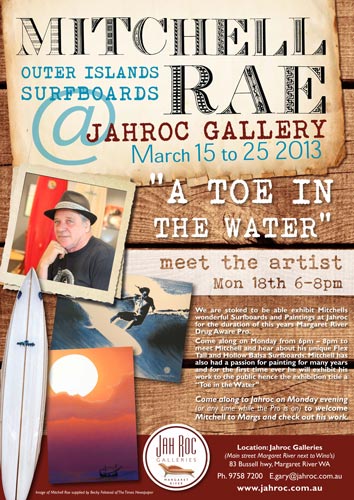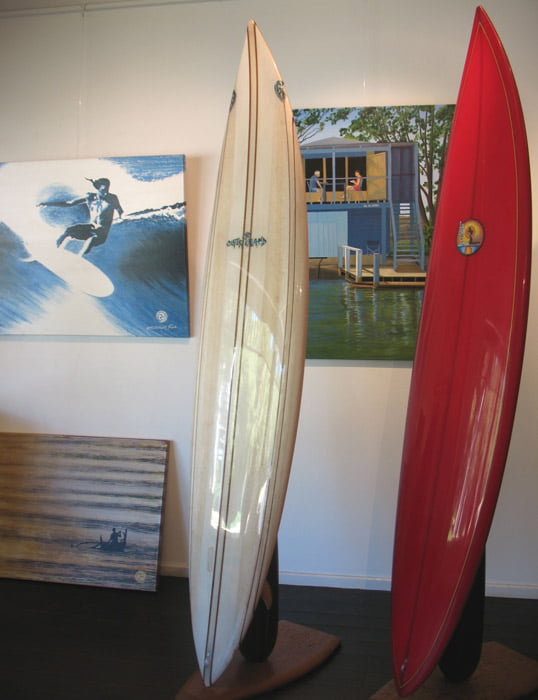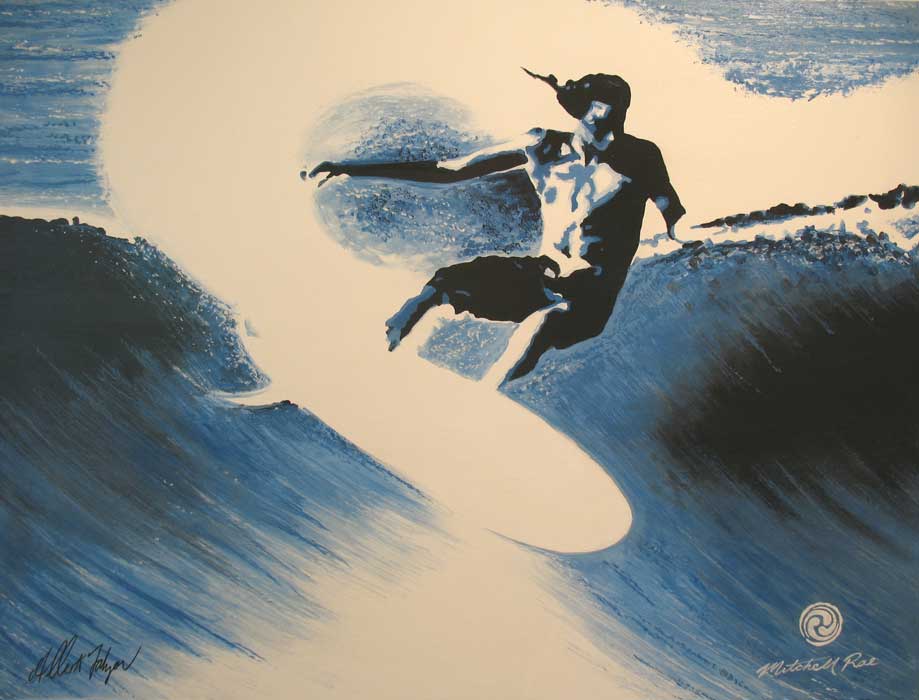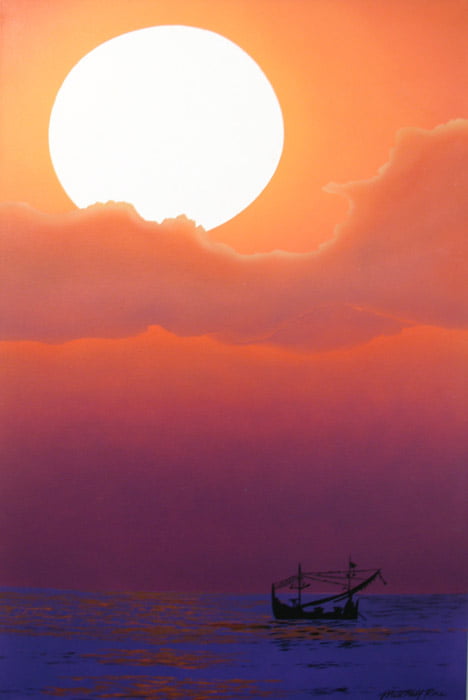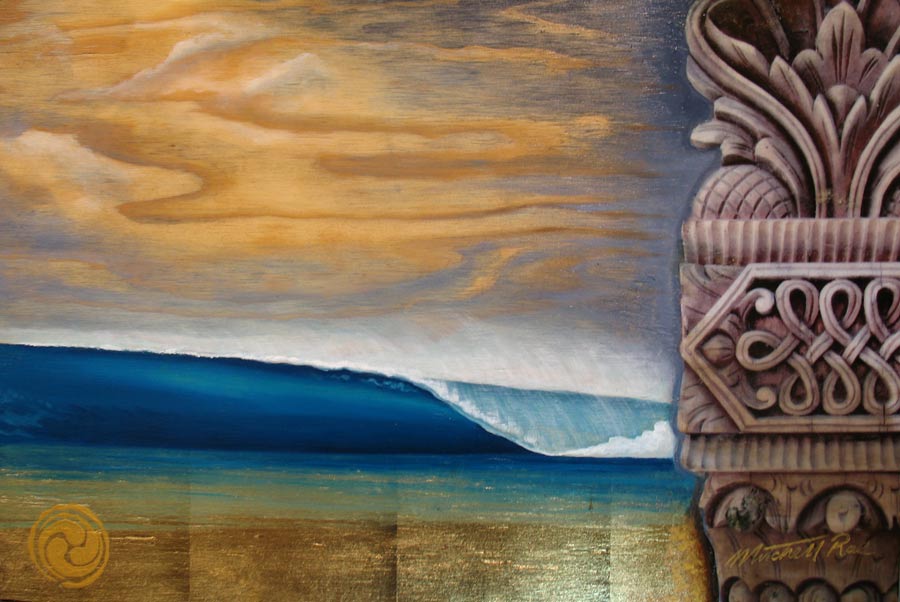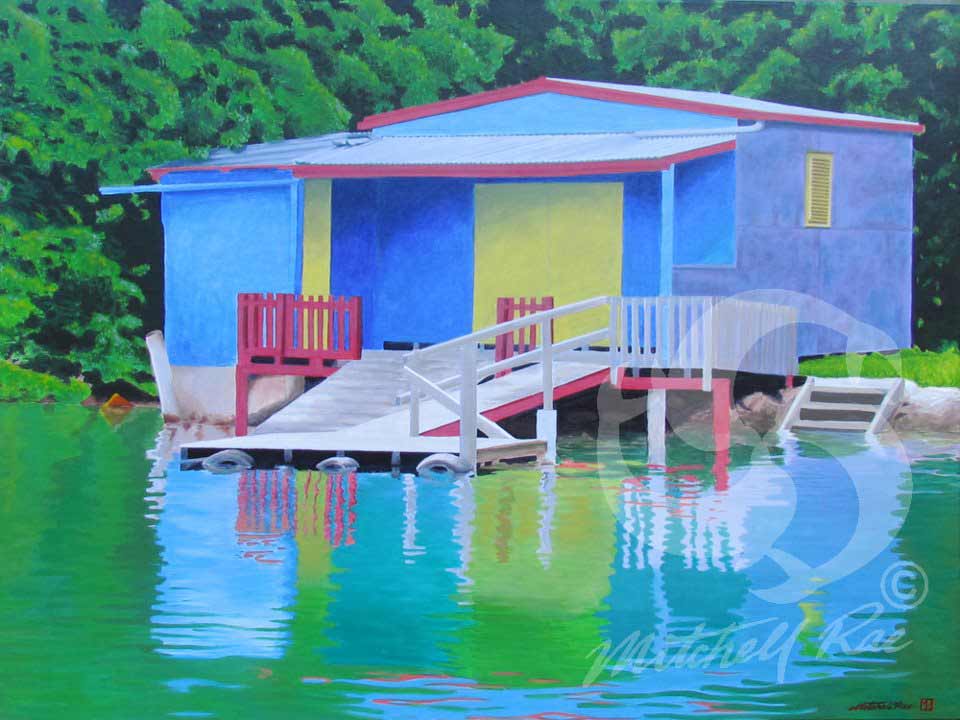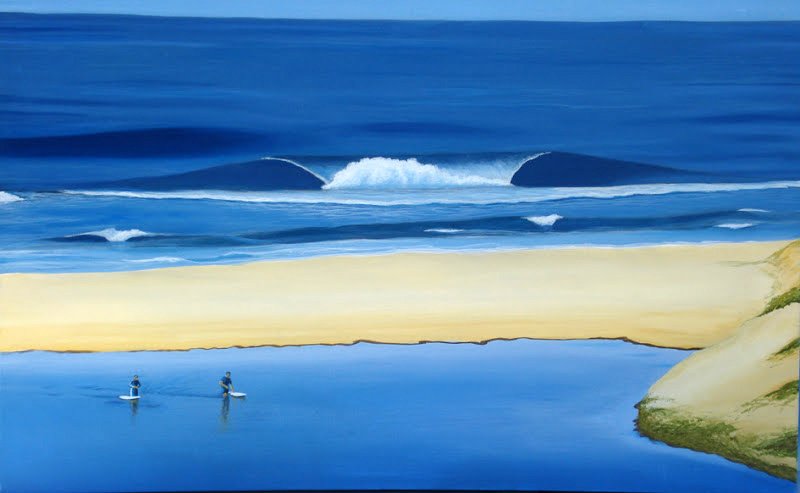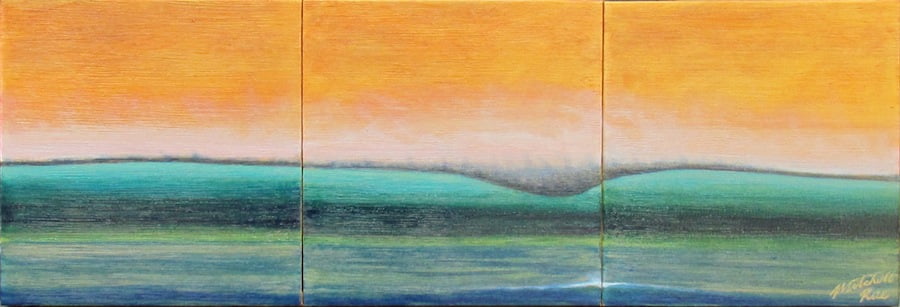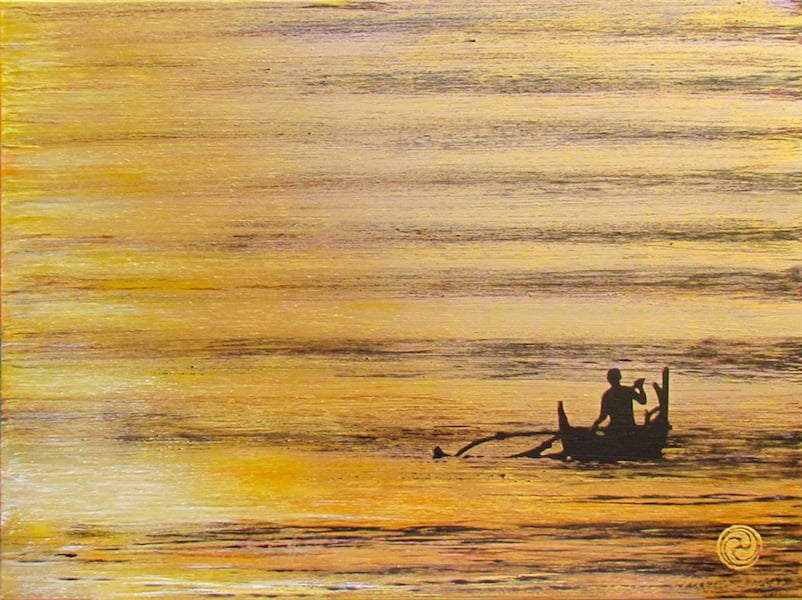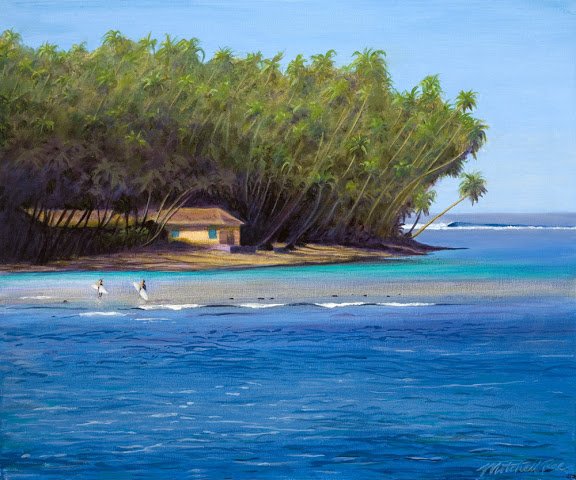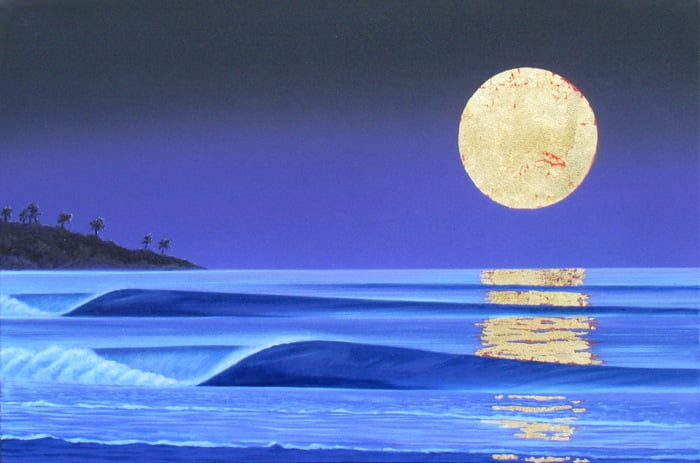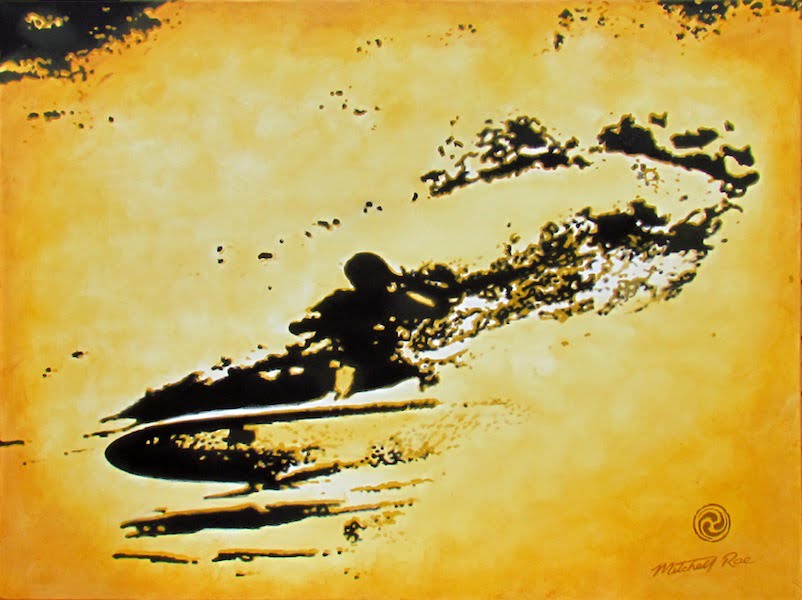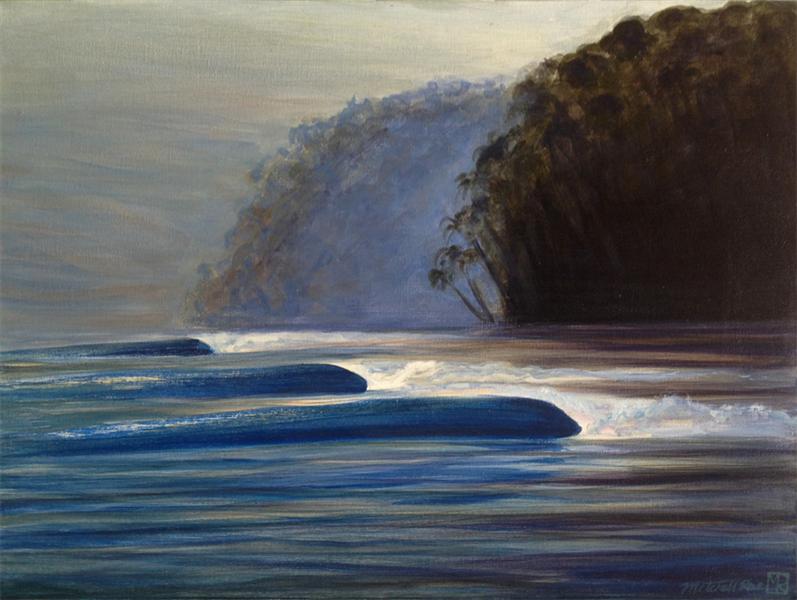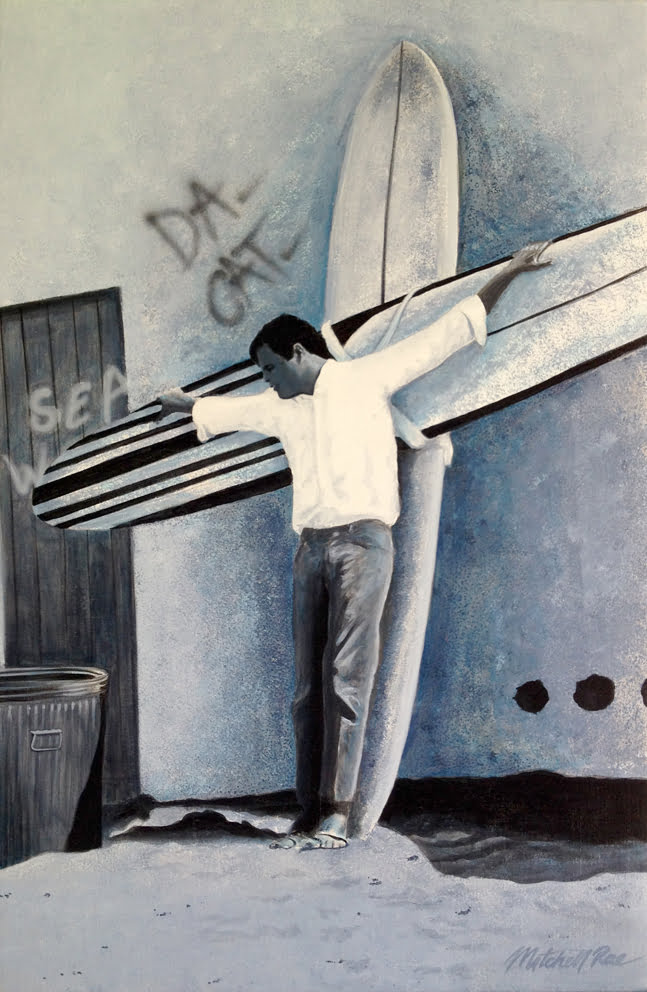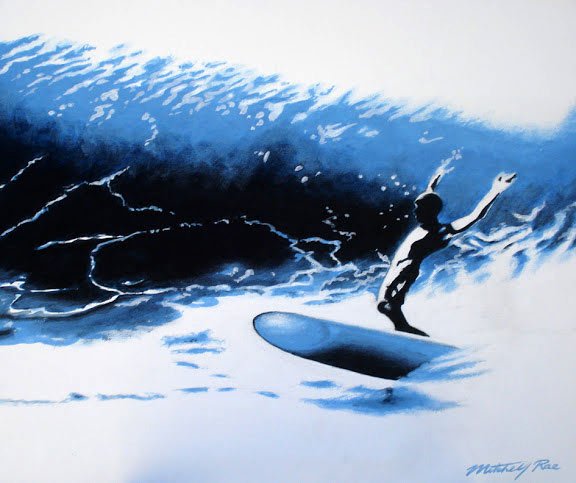Mitchell Rae is one of the world’s leading surfboard shapers, who also paints incredible scenes of the ocean and the surf – his artworks are inspired from his passion for surfing and travelling.
Mitchell Rae’s paintings capture the moment that is being a surfer.
“I am inspired by nature. I grew up surfing and around the ocean, it’s the force that has shaped my life.
I love the intense light and shimmering colour on the water, the mysterious dark depths, and the sparkling light dancing on the surface.
I like to work in a variety of media: photography, drawing, airbrush, hand painting in watercolour, gouache, acrylic and oil.
I’ve been exploring a diversity of styles and technique.
Presently I am looking to par the image down to its primal elements, distilling it to the essence, keeping it raw and expressive.
I’m keeping a raw edge to my work… my feeling is that if you want photo realism, reach for your camera!
I like to work out doors, ‘en plein air’ when time allows, capturing the essence of a place, often in small gouaches.
When planning a painting, I usually have a vision in mind. I get great satisfaction when I can develop it and make it work.
For me painting is a form of meditation… entering a timeless space far from the daily reality…
I like to think of images as portals, a departure point you can gaze through and let the mind wander…”
Mitchell Rae 2013
Join us at JahRoc Galleries and meet Mitchell Rae, hear him talk about his surfboards and artworks in an intimate group setting. Enjoy a beer or a glass of wine and celebrate the coming together of surf and art.
Surfboards and Art on Show:
THE SPIRIT EYES / FLEXTAILS / BIO / 2013
Born in ’55, raised at DY beach, which was the epicentre of Australian surfing in the 60’s, frequented by the likes of Midget and Nat. Brookvale, just over the hill, was the home of the surfboard building and iconic labels of the era like Barry Bennett, Scott Dillon, Bill Wallace and Gordon Woods. Mitchell Rae was one of the better surfers of his generation. He shaped and built his first board in his friends shed at age 12. Teaming up with board makers Glenn Ritchie and David Chidgey they formed Outer Island Surfboards in 1969, building their radical, innovative designs at Taman Shud’s house overlooking Newport before moving into Midget’s old spot in Gow’s Boatshed at Palm Beach. The Outer Island crew were doing deep single concaves in the late 60’s when most boards had rolled bottoms and S decks. Abandoning the contest scene, Rae was the test pilot for these revolutionary deep concave, hard railed designs. Mitchell has continued to pursue many of those design directions, developing single to double, triple and various concave configurations.
He was among the first wave of surfers to migrate to the North Coast in the early ’70’s. Travelling to Bali in ’72, the year of Morning of the Earth, Mitchell was amongst the early pioneers of Indonesia. He later travelled extensively to Hawaii, honing his skills in shaping mini guns and guns.
Mitchell Rae has shaped for many of the world’s great surfers… Luke Egan, Rasta, Parko, Rob Machado, Drew Courtney, Glen Hall , Derek Hynd ,Kai Otton and Adam Melling to name but a few.
One of Mitchell’s passions is building wooden boards, masterpieces that “will be around when I’m pushing daisies”.
A national award winning graphic artist, he also likes to draw, paint and play guitar for pleasure and relaxation.
He now resides on the mid North Coast at Urunga building small numbers of exquisite custom boards for an international clientele. THE SPIRIT EYES
By Phil AbrahamMitchell Rae started applying the distinctive eyes to the nose of his boards after he first visited Bali in 1972, and saw eyes on the bows of local fishing boats. Inspired by the concept Mitchell designed the trademark eyes which feature extensively on his boards.
“Balinese folklore instilled the belief that the ocean was full of evil spirits, so the local fishermen, the majority of whom couldn’t swim, felt the eyes on the front of their canoes protected them from the spirits. The spirit eyes, I call them. They take your board out of the realm of foam and fibreglass. They encapsulate the quest for the higher level of the surfing experience. It also gives the boards a bit of life, he adds. It animates them. Sometimes you look at them they are alive!”
Outer Island boards have ended up in many corners of the surfing world. A lot of Mitchell’s market is travelling surfers who do their annual or biannual pilgrimage to their favourite surfing paradise. So Outer Islands have lived up to their name and ended up in Indo, the Pacific, the Maldives, Fiji, Hawai… and lots of even more out of the way places. You can visit some real surfing frontiers and you’ll bump into someone with eyes on his boards and you’ll inevitably start talking. Over the years, the Outer Island spirit eyes have become a kind of a cult thing, and some of Mitchell’s clients have amassed extensive quivers of 20 and 40… Morning of the Earth creator, Albe Falzon, reckons he owns ten. “I don’t invest in real estate,” jokes Albe, “I collect Outer Island surfboards.”
DISCIPLES OF FLEX
Dave Rastovich reckons they’re fun, Andy Campbell has been riding them at Shipsterns and icons from Kelly Slater to Bob McTavish say they may be the key to the future of the surfboard. Flex has been around ever since the ’60s, when George Greenough carved up Lennox on his flextail spoons. But, despite its potential, flex remains an unknown attraction for most surfers.
Quite a few shapers, Chris Brock, Gary Keyes and the early Wilderness crew to name a few, have dabbled with flex, but Outer Island’s Mitchell Rae is the man when it comes to contemporary flextail design. He’s been making a range of flextails for a limited but appreciative clientele since the early 70’s.
Flex is the way of the future, says Mitchell. He believes that they have been little explored in production board making due to the highly intensive labour process required to build them. “We can make 3 regular boards in the time it takes to build one Flextail.”
LESS IS MORE
Rasta first rode a flextail some years ago. “Dick van Straalen made it… he did it out of curiosity. I was only 15 or 16 years old. It went amazingly, but it was just built with normal glass and it deteriorated fairly quickly. The next time I got on one was when we were filming Blue Horizons with Jack McCoy and Jack had a couple of Mitchell’s. “One of the reasons I like them is because sometimes when I’m surfing I like to do less. I don’t have to do as much on a flextail.” Rasta continues. “I like a board that gives back to me I like my board to respond. One turn can load it up, and you let it go and it just creates its own speed. You don’t have to push it all the time. You just load it up like a spring and let it go. They’re a part of my quiver. On different days and in different moods, I’ll pull my flextail out”
Derek Hynd is a disciple of flex. “I could see how flex operated when watching Mike Stewart getting three barrels through Rocky Point on his bodyboard which allowed him to get flex and release without drag. A 7’4″ Outer Island Flextail that I rode in six foot Jeffreys Bay gave me the same sensations. The board flew along the flat and rocketed off the top.”
ORIGENS OF FLEX
“Inspired by George Greenough’s flexible spoons, I’ve been on a 40 year quest to incorporate flex into my surfboard designs. I was favoured by fortune to do a lot of surfing at Lennox Head with George in the early 70’s, watching the way his little spoons could flex, carving incredibly tight arcs, generating speed and drive, fitting into the hollow wave faces.
A keen fisherman and naturalist, he opened my eyes to the way nature’s designs work, showed me how fish can change the shape of their fins in motion, altering aspect and shape while hunting prey, extending fins to change direction at hi speed, flattening them down to reduce drag. Sea birds will extend their wings to soar, tuck them in to dive at maximum speed, extend them to perform a high speed turn. Similarly, jet fighters change their wing form in flight. So do jumbo passenger planes. Using flex you can get a whole range of drivelines, from short and vertical, to long extended acceleration.
While George was prepared to sacrifice volume and paddle power to achieve flex, I wanted to maintain the wave catching and paddling ability of my boards. My original Flextail designs used a blade like flexible fibreglass tail section, sacrificing only a marginal amount of buoyancy to create the flexible tail. With the advent of boogy boards I incorporated these soft, flexible materials to replace sculpted out foam and restore the original profile and volume, allowing the flex to come forward into the fin area.
Like a dolphin’s tail, Flextails generate propulsion, drive and acceleration out of the turns.
The tail flexes as you apply power, carving a tighter arc. Energy is stored in the carbon tail, and is released out of the turn (reflex) delivering a massive burst of drive and speed, like an arrow from a bow, or a diver launching from a spring board.
Unlike conventional boards which are rigid and have one inbuilt set of curves, they feel alive to ride, changing shape while in motion, carving variable arcs and springing out of turns like Formula 1 race car. Flextails will hold the line for longer because it can flex into the wave without breaking traction.
“It’s like driving a fast on a racetrack, if you lose traction you go sideways, losing control and speed. Flex can generate whole range of drivelines, from short and vertical, to long extended speed lines.”
Constructed with carbon fibre and cross linked resins with ribs to fine tune the flex pattern , the Flextail is precision built to match the body weight of the rider and power of the waves to make the most the most technically advanced surfboards available on the planet.
Flex is the way of the future, says Mitchell. He believes that they have been little explored in production board making due to the highly intensive labour process required to build them. “We can make 3 regular boards in the time it takes to build one Flextail”.
V2 Flex
Mitchell’s latest innovation is V2 Flex, a unique, revolutionary design controlling the overall flex pattern of a surfboard. 2 stringers in an inverted V shape come from the nose and exit the rail forward of the fins, allowing the tail to flex, utilising the natural flex properties of the materials to their maximum. It puts the flex where you want it… in the tail section, and stiffens the board through the forward section. V2 Flex boards feel sensitive and alive under foot, flexing into the turns to give tighter arcs, greater hold on the wave and delivering a burst of drive (reflex) out of the turns. Over 10 years of research and development have gone into perfecting this design concept. We have been constructing over 90% of our boards this way for the last 5 years, and everyone who has one agrees that they are sensational to ride. Remarkably, the way the kinetic energy is transmitted through the board, we are not seeing broken tails, even in light weight Performers and Longboards. Less labour intensive than our full carbon fibre Flex Tail, it brings flex construction to a competitive price, affordable by everyone. The concept works equally effectively right through the size range, from shortboards, through mid length and longboards. The absolute cutting edge of performance technology employs the V2 Flex concept coupled with our proven carbon fibre FlexTail.
Many of our clients will ride nothing but Flextails…. once you discover the feel of flex, there is no turning back!
Invest in Technology!
JahRoc Galleries currently have no Mitchell Rae surfboards or artworks for sale.
[maxbutton id=”1″ text=”View All Artists – Art Gallery” url=”/gallery-category/artists” target=””]

